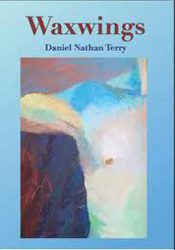
Daniel Nathan Terry’s second collection of verse, Waxwings, opens with “Scarecrow,” an address to the poem’s namesake from its creator: “Scare-crow crafter, burlap-tailor, / black-eye smudger, when I’m done, / crows mistake you for a man.” By the end of this first poem, it becomes clear that the scarecrow, constructed to protect the farmer’s crop, is used and thrown out by the very forces that make him; “How long,” ask the final two lines of the poem, “before the snow and I / take you down?”
Laced with imaginative diction, acrobatic-yet-precise internal music, and figurative language, “Scarecrow” forecasts what is to come: a collection of musical, symbolic, and highly-structured narratives that tell Terry’s story in three, chronological sections: the first of his experiences with rejection as a homosexual boy in the South, the second of his tumultuous and often terrifying adolescence, and the third of the oddly-discomfiting peace he finds as an adult.
The first section’s primary tool is symbolism. In the title poem, for example, Terry observes a waxwing gathering berries from a holly only to pass “it to its neighbor, // who passes it in turn, and so on down the [telephone] wire” until each bird is fed. The boy internalizes such a notion of community when, at the poem’s center, he “fantasizes / that kids in his class break into song // and dance like fools in an old musical.” Two poems later in “They were Call Colored,” Terry’s first gay lover (one of the blacks who works the farm next door to his home) slays a copperhead. When Terry inspects its body a few days later, he finds it writhing with maggots: “The snake was dead, but thousand of little white lives // wouldn’t let it rest.” Similarly, in “Flattened Penny,” “Lincoln’s face [is] erased” by a train, the penny “thin as a holy wafer, transformed by the weight // and might of the Southern Rail.” In “Photograph, 1984” Terry imagines a snake he’s watched eat a blackbird become the blackbird itself. And, finally, in “Since they put you out,” even inanimate objects reject Terry whose family has just rejected him: “no chair receives you, / no bath invites you, / no stove pot simmers / you to supper…” The primary message carried by these symbols are of rejection and for a desire to invert one’s sexual orientation, not to reject the self but to undo (much like the blackbird and snake) whatever action has made Terry who he is.
The poems of the second section merge Terry’s symbolic, boy-hood narratives with highly-organized structural subtext in poems about his adolescence as an exile. In “He Comes to Oak Island,” the speaker observes an “ibis dabbl[ing] in madly / in the wet sand” after he’s learned he is HIV positive and wonders “whose name its inscribing // in the Book of the Dead.” Similarly, “Elegy Written in November,” eulogizes the death of Terry’s friend David via disjointed sections each with their own form and title. And the last (perhaps best) poem of the section, “Snow falls in Hartsville,” is a contemporary sonnet sequence that depicts Terry’s attempt to reject his homosexuality and have a relationship with a girl who turns out to be gay herself. Unlike most sequences of this sort, Terry daisy-chains each sonnet to the last by mirroring the final line of each sonnet in the next. This structure creates a cyclical effect that reminds us of the inversion of the snake and blackbird in “Photograph, 1984.” This poem’s message, however, is entirely different. By the end of “Snow falls in Hartsville,” Terry accepts who he is, the girl he once tried to love is now “the man she was always meant to be,” and he has accepted his fate.
In the third and final section, we encounter less symbolic, less structural, more direct poems about domestic life. They are direct for a reason: Terry now has a partner, a career, and a passion that fulfills him; life since his adolescence has settled in, and the objects in his world (be they living or inanimate) no longer teem with implication. Things simply are what they are, and Terry seems a bit restless with his new rank. He’s not unhappy, but he does seem a bit unsure how to proceed in his life and work. In “Landscaper’s Curse,” for example, Terry can’t help but critique the “well-kept bungaloes / … / painted in colors that intimate / quirky wines in wrought-iron racks…” even though he is surrounded by beauty In “A Rumor of Fire,” though Terry and his a partner have bought a home together (“two bedrooms, one bath, a narrow living / room— all we could afford”) he realizes he’s “never lived / in a house I have loved.” And, in “Lost,” he says
….my lover fell asleep
on the couch again
last night and did not come
to bed. Nothing to do
with fighting, no anger,
just a decade or so since first love,
and now too much work,
and the fact that I’ve begun to snore
like an old man.
 The collection ends more hopefully with “Everything is Possible,” a poem that, much like a villanelle, cycles through a series of repeated, internally rhyming lines that declare “in this room of open windows… exists another window / across your knees” and “in this world of open screens, nearly everything / can be remembered.” While Terry may be restless, life is all around him and, perhaps, the poem declares “…Though some memories, / you know, are lost, misfiled, because … / …this librarian, like you, is sometimes distracted / by music and by luminous updates from the future.”
The collection ends more hopefully with “Everything is Possible,” a poem that, much like a villanelle, cycles through a series of repeated, internally rhyming lines that declare “in this room of open windows… exists another window / across your knees” and “in this world of open screens, nearly everything / can be remembered.” While Terry may be restless, life is all around him and, perhaps, the poem declares “…Though some memories, / you know, are lost, misfiled, because … / …this librarian, like you, is sometimes distracted / by music and by luminous updates from the future.”
Waxwings is a wonderfully constructed and brave collection of poems. It takes the reader on a journey not only through Terry’s life but into a culture that that has such a difficult time accepting those who are different. While most of these poems tell stories, they deftly employ a lyricism and subtext that make for a beautiful and intriguing read. Given Terry’s subject matter, he could easily have settled for poems of extreme story or of extreme lyricism and experimentation. In a time in which contemporary poetry seems to pick one or the other, Terry chose in Waxwings to bring these approaches together. He has done brilliantly so.




